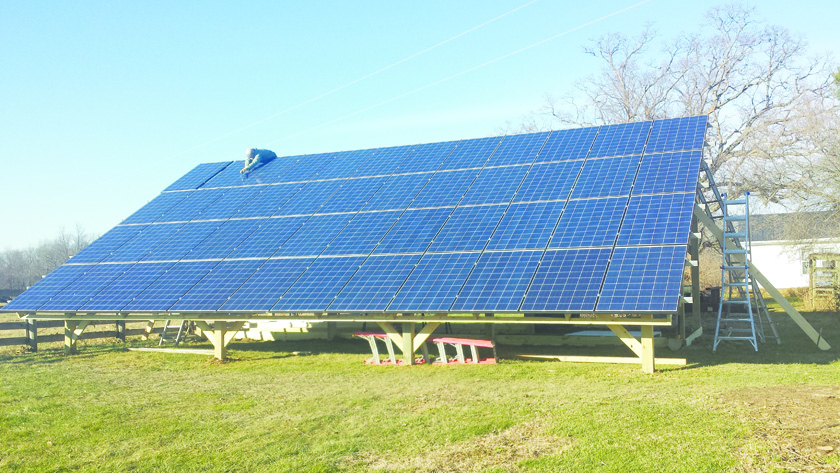
By Patricia Beech-
Solar is the fastest growing source of energy in the United States.
Despite a 30-percent tariff levied on imported solar cells and modules in January of last year, the U.S. added more solar power than any other type of electricity in the first quarter of 2018, and solar installations across the country only fell by about nine percent for the entire year.
While the bulk of the new solar capacity added came from utility-scale projects that feed power into the grid, the increase in accessibility to solar power has led to an uptick in personal solar power use – and not just for those pursuing an off-the-grid lifestyle.
Several Adams County families are among those who have discovered the advantages of going solar.
Andrew Frowine and his wife Laura had a residential solar PV (photovoltaic) system installed at their Adams County home near Peebles over five years ago.
The system has 36 – 220W solar panels mounted on the roof of a carport Frowine built especially for that purpose.
The Frowines also purchased a special reversing electric meter called a “net meter” that allows them to stay connected to the grid.
With the net meter in place, the power generated by their small system is transferred into the larger system of their utility provider – Adams Rural Electric (REA).
Since installing their solar array, Frowine has helped six other home owners put in systems of their own.
He says they all share a common motivation for turning to a clean energy source.
“Laura and I feel that every watt that we save we are giving as a gift to our children, our grandchildren and future generations,” he says. “All of the people I have helped who have done this are in their 60’s or older. They made a significant investment into solar not just to save money but because they were concerned about the environment and future generations ability to have enough clean energy.”
Steve and Amy Hedrick, owners of the organic-based Mound View Farm near Peebles, were among those who Frowine helped to acquire a personal solar power system.
The Hedricks installed a total of 60 solar panels – 48 on a standing framework and 12 on the roof of their summer kitchen – all are hooked into the REA electrical grid and produce approximately 15,000 Kw of power.
“We make electricity during daylight hours and at night we’re back on the grid,” says Hedrick, “We normally make more than we use, so we get credit for that.”
According to Frowine, power flows into the grid when a solar array is producing (when the sun is shining) and out of the grid when use is higher than production during nighttime hours.
“Users are charged each month for the ‘net’ difference between what is produced and what is used,” he explains. “In the summer we generate more power than we use, in the winter, primarily due to clouds – though cold weather does not stop the system from generating power – we often have to supplement what we produce with purchased power from REA.”
Frowine would like to see the government pursue more green energy alternatives.
“It is really unfortunate to see intelligent people in positions of power overlook solutions that are staring us directly in the face,” he says. “Not aggressively harvesting abundant, clean, and renewable solar energy is a huge shortsighted mistake.”
Both Frowine and Hedrick expressed disappointment in the Public Utilities Commission of Ohio (PUCO) recommendation against building the state’s largest solar facility in Mowrystown in Highland County.
“Not only would it produce electricity, it would provide a lot of jobs here,” says Hedrick. “If they’re buying electricity out of state, than our money is going out of state as well.”
Frowine believes the PUCO Commissioners are on the wrong side of history.
“Scientists have calculated that there is enough potential electric solar energy hitting Earth each day to cover all of the consumption needed,” he says. “Why reduce the analysis to some oversimplified study that considers only current and near future demand in one region of the US? Once power is produced and put into the grid, it can be used anywhere that is connected to the grid and it is available at the speed of light.”
Frowine believes the PUCO needs to take a broader view of power generation that is more in sync with current energy trends and needs.
“The PUCO needs to lead the way, to encourage average citizens and corporations to invest in more solar power,” he says. “They should not throw up roadblocks that create confusion and doubt which tends to stifle the development of solar technology that will provide benefits for all now and into the future.”
Frowine also points to mounting scientific evidence from U.S. government agencies that burning oil, coal, and natural gas is heating the planet and leading to drought, floods, wildfires, and more frequent powerful storms.
“One would think with all of the recent discussion and scientific evidence pointing to man’s high carbon footprint contributing to a spiraling, looming climate change crisis, that anything we can do to lessen our impact on the problem would be enthusiastically embraced,” he says, adding, “What happened to the concept of being guardians of the planet that we all share?”




